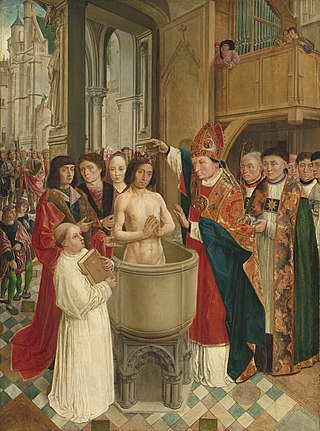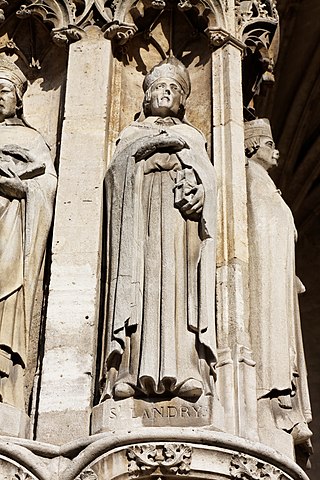
Clovis was the first king of the Franks to unite all of the Frankish tribes under one ruler, changing the form of leadership from a group of petty kings to rule by a single king and ensuring that the kingship was passed down to his heirs. He is considered to have been the founder of the Merovingian dynasty, which ruled the Frankish kingdom for the next two centuries. Clovis is important in the historiography of France as "the first king of what would become France".

Jean Raspail was a French explorer, novelist, and travel writer. Many of his books are about historical figures, exploration and indigenous peoples. He was a recipient of the prestigious French literary awards Grand Prix du Roman and Grand Prix de littérature by the Académie française. The French government honoured him in 2003 by appointing him to the Legion of Honor, with the grade of Officer. Internationally, he is best known for his controversial 1973 novel The Camp of the Saints, which is about mass third-world immigration to Europe.

Sigebert III was the Merovingian king of Austrasia from 633 to his death around 656. He was described as the first Merovingian roi fainéant —do-nothing king—, in effect the mayor of the palace ruling the kingdom throughout his reign. However he lived a pious Christian life and was later sanctified, being remembered as Saint Sigebert of Austrasia in the Roman Catholic Church and Eastern Orthodox Church.

Remigius was the Bishop of Reims and "Apostle of the Franks". On 25 December 496, he baptised Clovis I, King of the Franks. The baptism, leading to about 3000 additional converts, was an important event in the Christianization of the Franks. Because of Clovis's efforts, a large number of churches were established in the formerly pagan lands of the Frankish empire, establishing a distinctly Orthodox variety of Christianity for the first time in Germanic lands, most of whom had been converted to Arian Christianity.

The Archdiocese of Reims or Rheims is a Latin Church ecclesiastic territory or archdiocese of the Catholic Church in France. Erected as a diocese around 250 by Sixtus of Reims, the diocese was elevated to an archdiocese around 750. The archbishop received the title "primate of Gallia Belgica" in 1089.

Vedast or Vedastus, also known as Saint Vaast or Saint Waast, Saint Gaston in French, and Foster in English was an early bishop in the Frankish realm. After the victory of Tolbiac Vedast helped instruct the Frankish king Clovis in the Christian faith of his wife, Queen Clotilde.

The Diocese of Orléans is a Latin Church diocese of the Catholic Church in France. The diocese currently corresponds to the Départment of Loiret. The current bishop is Jacques André Blaquart, who was appointed in 2010.

The King's Camelots, officially the National Federation of the King's Camelots was a far-right youth organization of the French militant royalist and integralist movement Action Française active from 1908 to 1936. It is best known for taking part in many right-wing demonstrations in France in the 1920s and 1930s.

Lièpvre is a commune in the Haut-Rhin department in Grand Est in north-eastern France. A monastery was built here in the eighth century by Saint Fulrad, who filled it with relics of Saint Cucuphas and Saint Alexander.

The Diocese of Nancy and Toul is a Latin Church ecclesiastical territory or diocese of the Catholic Church in France. After a considerable political struggle between Louis XV, Louis XVI, and the Dukes of Lorraine, the diocese was erected by Pope Pius VI on 17 December 1777. The Diocese of Nancy is a suffragan diocese in the ecclesiastical province of the metropolitan Archdiocese of Besançon.

Saint Mansuetus was the first Bishop of Toul.

Saint Landry or Landericus of Paris was a bishop of Paris and is recognized as a saint by the Roman Catholic Church. Landry built a hospital dedicated to St. Christopher, which later became the Hôtel-Dieu de Paris. His feast day is 10 June.
Auspicius of Toul was a 5th-century bishop of Toul, the fifth of those recorded, and a saint of the Roman Catholic church. He was also a poet, known for iambic verse based on stress ; this was an innovation of his time. A verse letter of his from around 470 to Arbogast, count of Trier, survives.

Henri Jules Charles Petiot, known by the pen name Henri Daniel-Rops, was a French Catholic writer and historian.

Saint Annemund, also known as Annemundus, Aunemundus, Ennemond and Chamond, was an archbishop of the Archdiocese of Lyon. Annemund was a councillor of Clovis II and a friend of Wilfrid of York. The year of his death is variously given as either 657 or 658. He is venerated as a saint in the Catholic Church.

François Blouet de Camilly, Comte de Saint-Pierre-sur-Dives, D.D.,, a French Catholic clergyman, was the 88th Bishop of Toul from 1706 to 1721 and the 117th Archbishop of Tours from 1721 to 1723.

Saint Amon of Toul was the second recorded bishop of Toul and is venerated as a saint by the Roman Catholic Church.

Saint Aprus was the seventh bishop of Toul. He has been considered a saint in Toul since the 10th century. His feast day is celebrated on 15 September.
Saint Albaud of Toul, otherwise Aladius or Albin was a 6th-century bishop of Toul. He is venerated as a saint in the Catholic church with a feast day celebrated on 1 March.

Saint-Maur Abbey, originally called the Abbaye des Fossés, is a former abbey now subsumed in the Saint-Maur-des-Fossés suburb of Paris, France. The remains and the domain of the abbey have been transformed into a pleasure park named Parc de l'abbaye. The former abbey building has been replaced by a square at the corner of Avenue de Condé and Rue de l'Abbaye. Some ruins remain, such as the Rabelais tower, the 19th century Bourières villa and the old fortifications. The remains of the abbey have been classified as historical monuments since 13 June 1988.
















